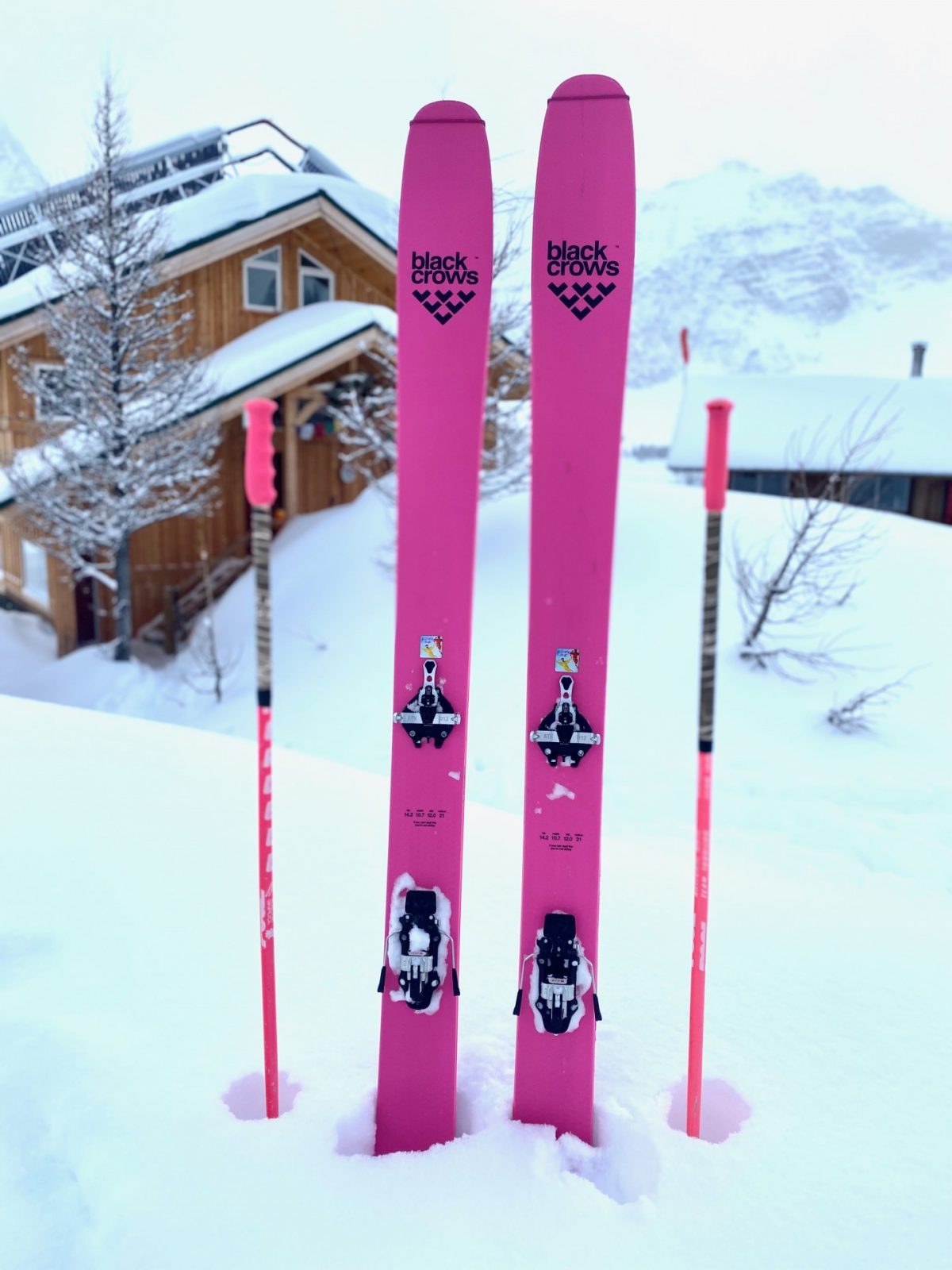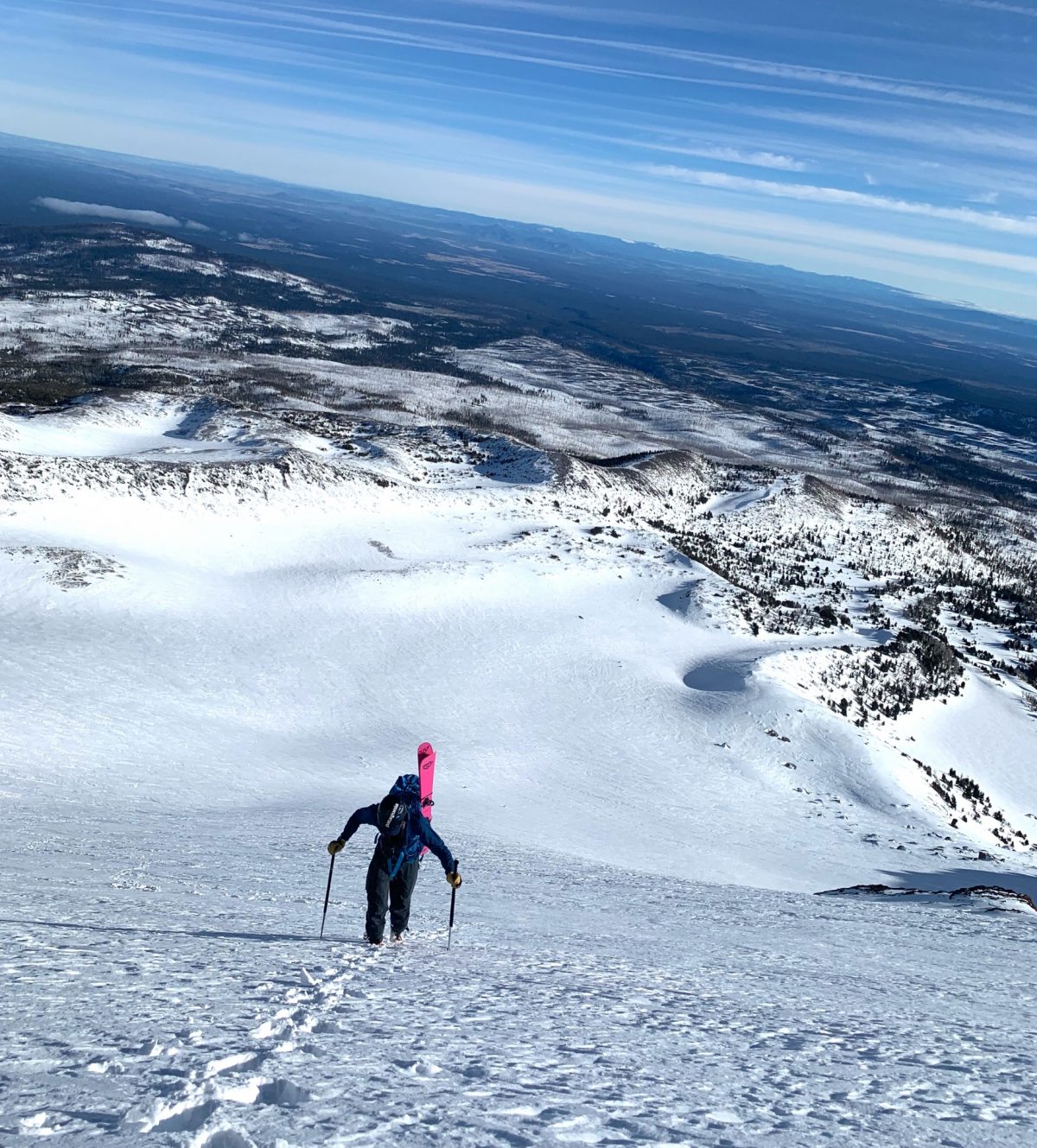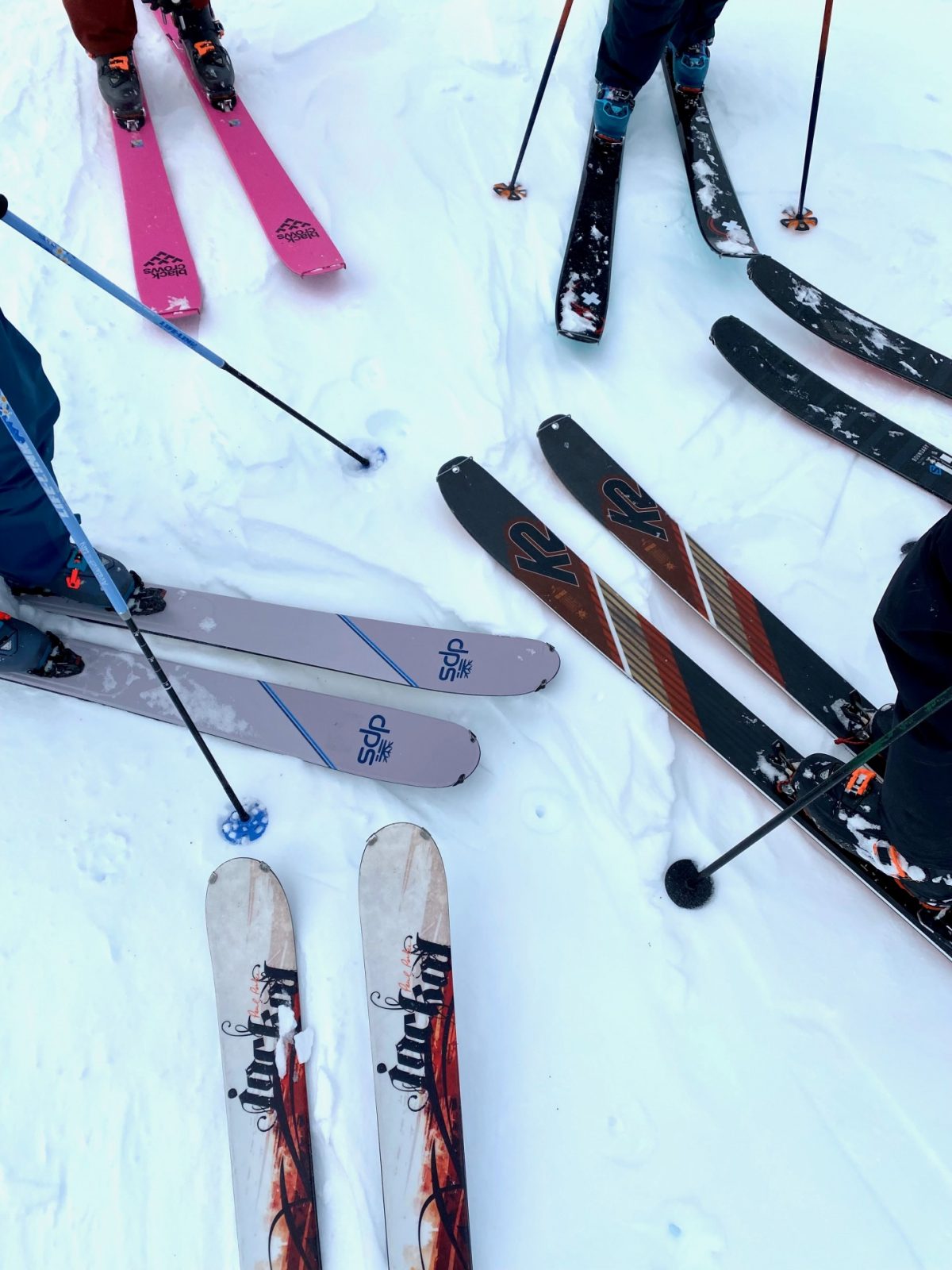
The Pink Ones: Black Crows Corvus Freebird can play in the pow, but seems more at home in steeper firmer conditions (this is a Chamonix brand) suiting its long effective edge for a 105+mm underfoot ski. Photo: Courtesy Barry Wicks.
The Black Crows Corvus Freebird comes in as a big mountain ready ski locked in for big turns on firmer snow. With 107mm underfoot, a straight tail, and modest tip rocker, the ski that is all pink feels more like an all-arounder than loose and free powder board.
Chuck D and Flavor Flav were onto something in 1988 when they released Public Enemy’s seminal album “It Takes A Nation of Millions to Hold us Back” and the track “Don’t Believe the Hype.” And what a lot of hype there is around Black Crows Skis. Bright colors, matching colored bases, ambiguous and erotic adjacent mottos written on the sidewalls. Never before has a ski garnered more comments from the skintrack to the helicopter ski basket.
As I alluded to in my first look at the Black Crows Corvus Freebird, the pink ski has a certain allure, or je ne sais quoi quality, in their native French parlance. I found it hard to resist the pull of the exotic french skis from Chamonix. The look, coupled with the Wes Anderson com Rene Descartes marketing material, convinced me that these skis would transcend all bounds and float with magic all over the mountain.
In my testing in my home mountains of Oregon and in the Canadian Rockies, I found a ski that, while solid and secure, left me with a feeling of, dare I say, disappointment? It’s not that the pink skis are bad in any objective sense, but the feelings they gave me under my feet and in my heart were just a bit less exotic than I hoped. So let’s dive in and square up those sensations.

The Corvus Freebird’s dimensions are (mm) 142, 107, 120. With an early rise tip and a flatter tail, this can serve double duty for powder and ski mountaineering objectives if you like a wider ski.
Specs:
Weight (g): 2019g (Size tested—188cm)
Dimensions (mm): 142, 107, 120 (188cm)
Profile: Traditional Camber, Early Rise Tip
Construction: Semi cap, glass, carbon, and 120cm double titanal plates
Core: Poplar
Radius: 21m
Recommended Use: Powder/Free Ride
Recommend mount position: -10cm
Price:$999.95 (A price increase since our first look.)
Performance
Uphill
As has been well established, the Corvus Freebird is quite heavy in the human-powered ski world. (3980g/pair) What I expected to find in this hearty package was a ski that could charge hard, with uncompromising downhill ability. You still have to lug them up the hill, though, and I found that the extra weight wasn’t too much of a factor for me on the skin track. Smaller skiers may find them cumbersome on the ups, however, so if you tend to find yourself sweaty and stressed near the back end of your ski group on the climbs or like a more spritely feel under your feet, these beasts may not be for you.

We are getting ahead on this: not all backcountry skiers mind hauling a 2kg ski up the flanks of a hill. The skier here is 18-years-old trending towards 19. So yeah, capable of hauling what WildSnow would call a heavier ski. Photo: Sawyer Smith.
Downhill
Firm, refrozen, wind board, and variable snow:
After weeks of a persistent high-pressure system at my home mountain range, I encountered firm, refrozen snow intermixed with chalky wind-filtered powder. The Corvus Freebird was a solid teammate here, unflappable on the firm surface, allowing easy (as could be reasonably expected) skiing with surprising edge hold for such a wide ski. Even when irresponsibly skied in poor conditions, the Corvus felt smooth and easy to manage throughout. The flat, powerful tail combined with ample tip dampness can be credited with this edgeablity and composure in variable conditions as they can be leaned on hard and keep coming back for more. If not skied hard, the flat tails can come back to haunt you, however, hanging up a little bit in the crud and crust if I didn’t take care to fully finish my turns. I was pleased with how composed the skis felt in tracked up and variable snow, all that beefy horsepower allowing a relaxed, plow ahead and just forget about all the tracks skiing style. The Corvus responded well to a somewhat heavy hand, although easy enough to manage with a lighter touch, a firm handshake brought out their best.
Pow — AKA the good stuff
In February, I traveled to Canada for a lengthy stint of work at a Talus Lodge. Fortunately, during one of my shifts, we were blessed with some cold, Canadian Rockies bluebird pow days. 40cm of fresh snow fell in 48 hours, then the storm dispersed without a hint of wind, and temperatures hovered around -7c. In these goldilocks conditions, any ski will shine, and the Corvus did well slipping in and out of knee-deep snow as I worked to stay out of accumulated sluff while I skied some of the more aggressive steep lines around the lodge. The Corvus felt smooth and easy, bopping through the deep stuff with glide and float as expected from a powerful 107mm waisted ski with some early tip rise. Short and longer radius turns were easy with slight adjustments in technique, and the powder freeride heart of the Corvus was evident. These skis were equally happy popping tight squiggles farming pow with guests, or just ripping the fall line and drawing much longer arcs.
How they Compare & Final Thoughts
One of the guides I work with at Talus has the mantra of “Underpromise and Overdeliver.” In this framework it is easy for an expectation to be met, or exceeded. Even as the Corvus easily handled all the snow conditions and terrain I threw at it with aplomb, I still felt like it was missing something. The skis worked great, but just didn’t give me the “fizz” in my heart I was hoping for. Somehow I had convinced myself that the Corvus Freebird would promise me the world but I just didn’t find what I was hoping for.

A group outing in the deep BC mountains means many types of wide skis. But the pink Corvus Freebird’s stand out. There is no doubt about that.
I have spent quite a bit of time on the Moment Wildcat Tour 108 in the 190cm length this year. This ski is lighter than the Corvus Freebird by about 300 grams per foot and has quite a different shape profile. The Wildcat is billed as a powder freeride ski just like the Corvus, but has a more progressive shape, with pronounced tip and tail rocker, and camber underfoot, what Moment calls “Mustache Rocker.” I found the Wildcat to be just as capable as the Corvus in pretty much all conditions, with the Corvus Freebird maybe just edging out the Wildcat on firm snow. I was still able to make very aggressive GS-style turns on the Wildcat Tour, which impressed me with its powerfulness for having so much rocker. Where the Wildcat outshines the Corvus is in playfulness and pop. For such a powerful ski, it can be tossed sideways any time the urge arises, and is just as happy surfing the hill sideways as it is locking into a high horsepower turn on hard snow.
Wildcat Tour 108 Specs:
Weight (g): 1859g (verified in size: 190cm)
Dimensions (mm): 134, 108, 127
Profile: Traditional Camber, Early Rise Tip
Construction: ABS Sidewall Sandwich Construction
Core: Paulownia/Ash Wood Core, LowFat Layup (Triaxial Fiberglass, Carbon)
Radius: 25m
Recommended Use: Powder/Free Ride
Recommend mount position: -6cm
It may be this ski that made me feel like the Corvus Freebird was slightly underperforming because with its different layup, shape, and geometry, the Wildcat feels more powder happy and poppy than the Corvus Freebird. The Corvus Freebird, though, may have an edge in total outright horsepower.
Pinpointing ski differences like noted above becomes clear when parsing the Corvus Freebird specs. Soothski claims the ski’s running length is 82% in the year model we tested (2022- 188cm). That’s something we see in great firm snow skis, not exactly skis for powder. And it explains the ski’s great vibe on firm snow and the somewhat lackluster powder sensations. The Corvus Freebird’s straighter tail, too, speaks more to the ski mountaineering and long radius turn realm ( ~21m) than skis with more tip and tail rocker and a looser overall ski experience. The Corvus Freebird will lock into a turn, but sometimes, that locked-in feeling quells the creative juices. With 107mm underfoot, you’re likely skiing a ski this wide for the smiles. In the Black Crows line, the Ferox Freebirds, with their generous tip and tail rocker, 110mm underfoot, will likely be your more playful powder hunter over the more all-around Corvus Freebird. But, if you want to straight line some steep couloirs in questionable conditions or at high speeds, the pink speed demons will be a solid and secure choice.
Shop for the Black Crows Corvus Freebird.
Barry Wicks, also known as @wicknasty, demphasizes the nasty and embraces the kindness. He lives in Bend, Oregon where in a parallel universe he covets all things cycling. And although he might not admit it, some say he was once quite speedy on a bike. Also, amongst WildSnow writers, he has the best hair.
